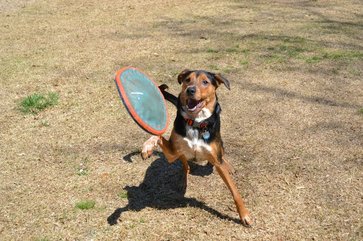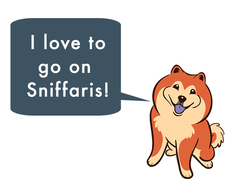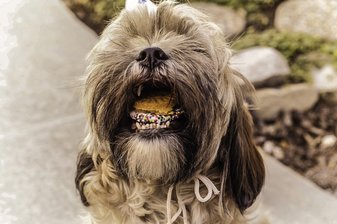Dogs Being Dogs
Many of the things that frustrate people the most about their dogs can be summed up as simply “dogs being dogs.” Things like chewing furniture, chasing bikes, barking at squirrels, and digging up yards are completely normal dog behaviors.
In fact, dogs derive great pleasure from doing these things. So if we can give them the opportunity to do the “doggie” things that they love — but in approved ways — they’ll be healthier and happier and likely be less destructive.
In fact, dogs derive great pleasure from doing these things. So if we can give them the opportunity to do the “doggie” things that they love — but in approved ways — they’ll be healthier and happier and likely be less destructive.
|
Imagine if you loved to read but were never given access to a book. Think of how much you would miss that activity. That’s essentially how dogs feel when we do not allow them to do what comes naturally to them.
It’s important to note that in all of the following “dogs being dogs” descriptions, pups who do not get enough exercise or mental enrichment may do much more of these behaviors than you might like. Conversely, when they do get to do them, they become more relaxed. After a dog gets her sniffs on or noshes on a good chew toy, she’ll likely be ready to chill out. |
Let’s take a look at some of these “doggie” things and see how we can turn them into a positive:
Sniffing
We, humans, get to know our environment primarily through our eyes. But dogs? It’s all about their noses. When we go for a walk, we follow a line-of-sight, so our route tends to lead in one direction. Dogs? Their noses are picking up smells all around them, and so they tend to veer off the path and sniff this post here, that fire hydrant there, and “oh yeah, wait, gotta go back for that freshly-peed-on tree behind us.”
To give you a sense (pardon the pun) of how powerful a dog’s nose is, consider this: We might notice if our coffee has been sweetened with a teaspoon of sugar. A dog can detect a teaspoon of sugar diluted into two Olympic-sized pools full of water.
To give you a sense (pardon the pun) of how powerful a dog’s nose is, consider this: We might notice if our coffee has been sweetened with a teaspoon of sugar. A dog can detect a teaspoon of sugar diluted into two Olympic-sized pools full of water.
Chewing
As with growling, we don’t want to punish a dog for chewing or teach him to stop. Instead, we want to teach him what is acceptable to chew and what is not. This is done the same way we housetrain a dog: keep him from chewing the wrong stuff (shoes, couch, pillows, etc.) by preventing access to those things and instead figure out what types of toys he loves and provide him plenty of them. (Get him hooked on Kongs, Bully sticks, rawhides, Greenies, etc. instead of your couch or shoes.)
While in most cases, chewing is simply a dog-being-a-dog behavior, sometimes dogs chew when they are anxious. The most common situation is when the dog is left alone. If your dog only causes destruction when he’s left alone, he might be suffering from separation anxiety. In these cases, rather than chew the couch, the dog would be likely chew doorframes or windows in an attempt to escape.
If your dog is chewing the wrong kinds of stuff, click here to find a qualified trainer to help you.
While in most cases, chewing is simply a dog-being-a-dog behavior, sometimes dogs chew when they are anxious. The most common situation is when the dog is left alone. If your dog only causes destruction when he’s left alone, he might be suffering from separation anxiety. In these cases, rather than chew the couch, the dog would be likely chew doorframes or windows in an attempt to escape.
If your dog is chewing the wrong kinds of stuff, click here to find a qualified trainer to help you.
Digging
|
Not all dogs dig, but those that do, do it for a variety of reasons:
|
If you have a yard and your dog digs, the best solution is to give him an approved place to do it — a kid’s sandbox works great, or an unused plant bed. For a couple of weeks, bury enticing things for your dog to find there to teach him that that’s the place to go to get his “dig” on.
Word of warning: Dogs who are left outside alone for long periods of time often become bored and, thus, dig. Like us, dogs need to interact with others, use their minds, and engage in physical activity. And just like us, if they don’t get those things, they can become bored, stressed, and anxious.
Visit Enrichment for information on how to keep your dog’s mind engaged, and/or click here to find a qualified trainer for more help.
Visit Enrichment for information on how to keep your dog’s mind engaged, and/or click here to find a qualified trainer for more help.
Food Stealing
|
As mentioned in How Dogs Learn, dogs do what works for them. Dogs are natural scavengers and finding food while foraging around is about as reinforcing as any behavior could be.
“It’s FOOD! And it’s just LYING AROUND FOR ME TO EAT IT! My life iz gud.” |
So, how do you keep your dog from raiding trash cans and kitchen counters?
Don’t give in to begging — Dogs do what works, and they stop doing what doesn’t. If you give in when your dog begs, he will continue to beg. If you ignore your dog when he begs, he’ll eventually learn that begging gets him nowhere and will stop doing it.
- Management — Seal up your trash cans, keep your dog out of the kitchen and dining areas if need be, and be careful about what food you do leave lying around.
- Alternative “legal” outlets — Hunting and scavenging for food are in dogs’ DNA, so give them puzzle toys and chew toys stuffed with food, and hide them for your dog to find. (Visit Enrichment for more information.)
Don’t give in to begging — Dogs do what works, and they stop doing what doesn’t. If you give in when your dog begs, he will continue to beg. If you ignore your dog when he begs, he’ll eventually learn that begging gets him nowhere and will stop doing it.
Chasing

As mentioned in Predatory Behavior, hunting behaviors are a part of dogs’ DNA, tracing back to their ancestor the gray wolf. Thus, it’s in many dogs’ nature to chase and bite things that — in their minds — retreat or are moving. Things like:
- Running children
- Cars
- Bikes
- Cats and other small animals
- Frisbees, balls
Also, dogs are more likely to chase if another dog is doing it. As Jean Donaldson puts it, “They egg each other on.”
If your dog has a high prey drive, give him plenty of opportunity to fetch a ball or Frisbee. These “legal” outlets will be a great release for his desire to chase.
If your dog has a high prey drive, give him plenty of opportunity to fetch a ball or Frisbee. These “legal” outlets will be a great release for his desire to chase.





